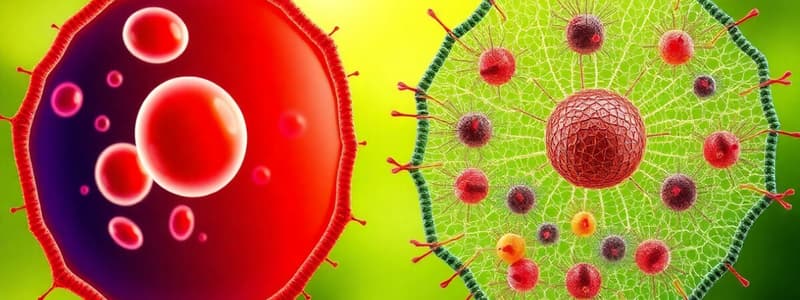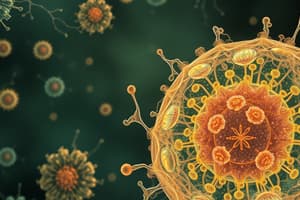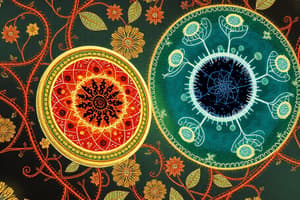Podcast
Questions and Answers
What is the primary component found in the outer mitochondrial membrane?
What is the primary component found in the outer mitochondrial membrane?
- Phospholipids (correct)
- Cardiolipin
- Proteins
- Cholesterol
What role does Porin play in the outer mitochondrial membrane?
What role does Porin play in the outer mitochondrial membrane?
- It facilitates ATP production.
- It assists in replication of mitochondrial DNA.
- It synthesizes fatty acids.
- It forms channels for diffusion of small molecules. (correct)
What is the lipid-protein ratio of the inner mitochondrial membrane?
What is the lipid-protein ratio of the inner mitochondrial membrane?
- 0.5:1
- 1:1
- 0.27:1 (correct)
- 1:0.27
What is a significant characteristic of the inner mitochondrial membrane?
What is a significant characteristic of the inner mitochondrial membrane?
What best describes the intermembrane space of the mitochondrion?
What best describes the intermembrane space of the mitochondrion?
Which enzyme processes occur within the mitochondrial matrix?
Which enzyme processes occur within the mitochondrial matrix?
What structures are formed by the folds of the inner mitochondrial membrane?
What structures are formed by the folds of the inner mitochondrial membrane?
Which of the following is NOT found in the mitochondrial matrix?
Which of the following is NOT found in the mitochondrial matrix?
What is a key function of the rough endoplasmic reticulum?
What is a key function of the rough endoplasmic reticulum?
Which condition is associated with dysfunction in the endoplasmic reticulum?
Which condition is associated with dysfunction in the endoplasmic reticulum?
What is unique about mitochondrial DNA?
What is unique about mitochondrial DNA?
Which type of endoplasmic reticulum is responsible for lipid synthesis?
Which type of endoplasmic reticulum is responsible for lipid synthesis?
Which organelle is involved in the detoxification of drugs within mammalian liver cells?
Which organelle is involved in the detoxification of drugs within mammalian liver cells?
What is the role of cytochrome P450 in the endoplasmic reticulum?
What is the role of cytochrome P450 in the endoplasmic reticulum?
How do free radicals affect mitochondrial DNA?
How do free radicals affect mitochondrial DNA?
The Golgi complex is also known as what?
The Golgi complex is also known as what?
What is the optimal pH for lysosomal enzymes?
What is the optimal pH for lysosomal enzymes?
Which enzyme is NOT associated with protein hydrolysis in lysosomes?
Which enzyme is NOT associated with protein hydrolysis in lysosomes?
Which of the following processes does NOT involve lysosomes?
Which of the following processes does NOT involve lysosomes?
What role does acid phosphatase serve in relation to lysosomes?
What role does acid phosphatase serve in relation to lysosomes?
In which type of cells are lysosomes NOT found?
In which type of cells are lysosomes NOT found?
What happens to lysosomal bodies during the autolysis of a cell?
What happens to lysosomal bodies during the autolysis of a cell?
Which of the following enzymes is primarily involved in lipid hydrolysis?
Which of the following enzymes is primarily involved in lipid hydrolysis?
Which condition can result from lysosomal dysfunction?
Which condition can result from lysosomal dysfunction?
What is the primary consequence of urate crystal deposition around joints in gout?
What is the primary consequence of urate crystal deposition around joints in gout?
What characterizes I-cell disease?
What characterizes I-cell disease?
What happens to lysosomal enzymes in I-cell disease?
What happens to lysosomal enzymes in I-cell disease?
Which of the following is a common feature of inherited lysosomal disorders?
Which of the following is a common feature of inherited lysosomal disorders?
What structure do peroxisomes share during their formation?
What structure do peroxisomes share during their formation?
Which of the following correctly describes the appearance of peroxisomes?
Which of the following correctly describes the appearance of peroxisomes?
What is the outcome of the lysosomal enzymes lacking Mannose-6-P?
What is the outcome of the lysosomal enzymes lacking Mannose-6-P?
How does the phagocytosis of urate crystals affect lysosomes?
How does the phagocytosis of urate crystals affect lysosomes?
What is produced during the oxidation reactions carried out by peroxisomes?
What is produced during the oxidation reactions carried out by peroxisomes?
Which of the following fatty acids can be oxidized by liver peroxisomes?
Which of the following fatty acids can be oxidized by liver peroxisomes?
What characterizes the cytoplasm (cytosol) of a cell?
What characterizes the cytoplasm (cytosol) of a cell?
What is the primary function of the plasma membrane?
What is the primary function of the plasma membrane?
Which component typically makes up about 60 percent of the dry weight of membranes?
Which component typically makes up about 60 percent of the dry weight of membranes?
What does selective permeability of the plasma membrane allow?
What does selective permeability of the plasma membrane allow?
Which inherited disorder is associated with the absence of peroxisomes?
Which inherited disorder is associated with the absence of peroxisomes?
How are all membrane carbohydrates typically attached?
How are all membrane carbohydrates typically attached?
What component of lipids makes the polar head hydrophilic?
What component of lipids makes the polar head hydrophilic?
Which types of lipids are specifically mentioned as being part of cell membranes?
Which types of lipids are specifically mentioned as being part of cell membranes?
How does the degree of unsaturation affect cell membranes?
How does the degree of unsaturation affect cell membranes?
Which of the following fatty acids is NOT a common unsaturated fatty acid found in membrane lipids?
Which of the following fatty acids is NOT a common unsaturated fatty acid found in membrane lipids?
What are the three types of sphingolipids mentioned?
What are the three types of sphingolipids mentioned?
Approximately what percentage of fatty acid groups in membrane lipids are saturated?
Approximately what percentage of fatty acid groups in membrane lipids are saturated?
Which fatty acid is the most abundant unsaturated fatty acid found in animal membrane lipids?
Which fatty acid is the most abundant unsaturated fatty acid found in animal membrane lipids?
What characteristic do lipids possess due to their structure?
What characteristic do lipids possess due to their structure?
Flashcards
Outer mitochondrial membrane composition
Outer mitochondrial membrane composition
Mostly phospholipids and cholesterol; contains porin proteins.
Porin protein function
Porin protein function
Forms channels allowing small molecules (<10,000 Da) to pass freely through the outer membrane.
Inner mitochondrial membrane composition
Inner mitochondrial membrane composition
High protein content (with a low lipid-protein ratio); rich in cardiolipin; resists the passage of polar/ionic molecules.
Cristae
Cristae
Signup and view all the flashcards
Intermembrane space composition
Intermembrane space composition
Signup and view all the flashcards
Mitochondrial matrix location
Mitochondrial matrix location
Signup and view all the flashcards
Mitochondrial matrix composition
Mitochondrial matrix composition
Signup and view all the flashcards
Inner mitochondrial membrane function
Inner mitochondrial membrane function
Signup and view all the flashcards
Mitochondrial function
Mitochondrial function
Signup and view all the flashcards
Mitochondrial DNA
Mitochondrial DNA
Signup and view all the flashcards
Endoplasmic Reticulum (ER)
Endoplasmic Reticulum (ER)
Signup and view all the flashcards
Rough ER
Rough ER
Signup and view all the flashcards
Smooth ER
Smooth ER
Signup and view all the flashcards
Golgi apparatus
Golgi apparatus
Signup and view all the flashcards
Mitochondrial diseases
Mitochondrial diseases
Signup and view all the flashcards
ER dysfunction
ER dysfunction
Signup and view all the flashcards
Lysosome Function
Lysosome Function
Signup and view all the flashcards
Lysosome Location
Lysosome Location
Signup and view all the flashcards
Lysosomal pH
Lysosomal pH
Signup and view all the flashcards
Lysosomal Enzymes
Lysosomal Enzymes
Signup and view all the flashcards
Acid Phosphatase Function
Acid Phosphatase Function
Signup and view all the flashcards
Lysosomal Autophagy
Lysosomal Autophagy
Signup and view all the flashcards
Lysosomal Autolysis
Lysosomal Autolysis
Signup and view all the flashcards
Acrosome and Sperm
Acrosome and Sperm
Signup and view all the flashcards
Lysosome function in gout
Lysosome function in gout
Signup and view all the flashcards
Inherited lysosomal diseases
Inherited lysosomal diseases
Signup and view all the flashcards
I-Cell disease cause
I-Cell disease cause
Signup and view all the flashcards
I-Cell disease effect
I-Cell disease effect
Signup and view all the flashcards
Lysosomal enzyme transport
Lysosomal enzyme transport
Signup and view all the flashcards
Peroxisome characteristics
Peroxisome characteristics
Signup and view all the flashcards
Lysosome deficiency symptom
Lysosome deficiency symptom
Signup and view all the flashcards
Microbodies
Microbodies
Signup and view all the flashcards
What are peroxisomes?
What are peroxisomes?
Signup and view all the flashcards
What's a key function of peroxisomes?
What's a key function of peroxisomes?
Signup and view all the flashcards
What is cytosol?
What is cytosol?
Signup and view all the flashcards
What are plasma membranes?
What are plasma membranes?
Signup and view all the flashcards
What does selective permeability mean?
What does selective permeability mean?
Signup and view all the flashcards
What are the main components of cell membranes?
What are the main components of cell membranes?
Signup and view all the flashcards
What is the purpose of internal membrane systems?
What is the purpose of internal membrane systems?
Signup and view all the flashcards
How does the carbohydrate content of membranes vary?
How does the carbohydrate content of membranes vary?
Signup and view all the flashcards
Lipid Structure
Lipid Structure
Signup and view all the flashcards
Fatty Acids in Membranes
Fatty Acids in Membranes
Signup and view all the flashcards
What impacts membrane fluidity?
What impacts membrane fluidity?
Signup and view all the flashcards
Glycerophospholipids
Glycerophospholipids
Signup and view all the flashcards
Sphingolipids
Sphingolipids
Signup and view all the flashcards
Why are lipids important for membranes?
Why are lipids important for membranes?
Signup and view all the flashcards
Lipid Roles
Lipid Roles
Signup and view all the flashcards
Lipid Diversity
Lipid Diversity
Signup and view all the flashcards
Study Notes
Cell Theory
- Each organism is composed of cells.
- All cells arise from pre-existing cells.
- The genetic code is passed down from one generation to the next.
- Metabolism encompasses anabolism and catabolism, chemical reactions within the cell.
Types of Cells
- Two main types: prokaryotic and eukaryotic.
Prokaryotic Cells
- Smaller in size, minimal internal organization.
- Lack membrane-bound organelles.
- Genetic material (DNA) is not enclosed by a nuclear membrane.
- DNA is not complexed with histones.
- Respiratory system is closely associated with the plasma membrane.
- Reproduction does not involve mitosis or meiosis.
- Examples: Bacteria and Cyanobacteria.
Eukaryotic Cells
- Larger size, complex internal structure.
- Contain membrane-bound organelles.
- Genetic material (DNA) is enclosed within a nuclear membrane.
- DNA is complexed with histones.
- Respiratory system is in the mitochondria.
- Reproduction involves mitosis and meiosis.
- Examples: Fungi, plants, and animals (including humans).
Cell Organelles: Nucleus
- Contains over 95% of the cell's DNA, the control center of the eukaryotic cell.
- Nuclear envelope: A double membrane structure separating the nucleus from the cytoplasm.
- Nuclear pore complexes: Embedded in the nuclear envelope, regulating protein and RNA movement.
- Chromatin: Coiled DNA within the nucleus.
- Nucleolus: A dense mass associated with the inner nuclear envelope involved in ribosome subunit assembly and rRNA synthesis.
- Nucleoplasm: The nucleus's contents including enzymes like DNA and RNA polymerases, which play roles in mRNA and tRNA synthesis.
- DNA replication and RNA transcription of DNA occur in the nucleus.
Cell Organelles: Mitochondria
- The powerhouse of the cell.
- Number: Varies greatly between cells.
- Size: Typically 0.2-0.8 µm in diameter.
- Shape: Assumes various shapes based on metabolic conditions.
- Mitochondria contain an outer and inner membrane.
- Outer membrane: Mostly phospholipid, cholesterol, and contains Porin proteins.
- Inner membrane: Abundant in proteins and cardiolipin, highly folded (cristae), resistant to the passage of polar and ionic molecules; facilitates the passage of polar and ionic molecules through transport proteins.
- Intermembrane space: The space between the outer and inner membranes. Has a similar ionic composition to the cytosol.
- Mitochondrial matrix: The region enclosed by the inner membrane, containing the enzymes of the citric acid cycle and fatty acid oxidation. Contains circular DNA, ribosomes, and enzymes required for protein synthesis encoded in the mitochondrial genome. The mitochondrion is partly independent genetically.
Cell Organelles: Ribosomes
- Small organelles responsible for protein synthesis.
Cell Organelles: Endoplasmic Reticulum
- Extensive network of membranes extending throughout the cell.
- Rough ER: Studded with ribosomes, synthesizes membrane-bound and secretory proteins, modifies and transports proteins. Modified and transported through the cell.
- Smooth ER: Lacks ribosomes; Involved in lipid synthesis, steroid hormone production, and detoxification of drugs and poisons.
Cell Organelles: Golgi Complex/Golgi Apparatus
- Stacked, flattened, membrane-bound sacs in eukaryotic cells.
- Modifies, sorts, packages, and transports proteins and lipids from the ER.
- Has a proximal (cis), medial, and distal (trans) section.
- Receives proteins from the ER via transfer vesicles.
- Post- translational modifications occur in the lumen.
- Carbohydrates and lipid precursors are added to proteins to form glycoproteins and lipoproteins.
- Secretory proteins are released via vesicles.
Cell Organelles: Lysosomes
- Cellular organelles containing digestive enzymes.
- Involved in intracellular digestion, breaking down waste materials and cellular debris.
- Optimal pH is around 5.
- Common in all animal cells (except red blood cells).
- Important for autophagic processes and cellular autolysis.
- The Enzymes in lysosmes are Hydrolytic enzymes, which are responsible for breaking down complex molecules. Enzymes include; proteolytic enzymes, nucleic acid hydrolyzing enzymes, lipid hydrolyzing enzymes, carbohydrate splitting enzymes, and other enzymes.
- Lysosomal dysfunction may cause allergic responses, arthritic conditions, gout, inherited disorders, and I-cell disease.
Cell Organelles: Peroxisomes
- Small organelles ("microbodies") containing enzymes involved in oxidation reactions.
- Produce hydrogen peroxide, then destroy it
- Oxidizes long-chain fatty acids.
- May be absent in some inherited disorders, like Zellweger's syndrome. Enzyme within the microbody/peroxisome is catalase.
Cell Organelles: Cytosol/Cytoplasm
- The contents of a cell outside the nucleus.
- Organelle-free sap.
- High protein content and rRNA.
- Metabolic reactions occur here.
Biological Membranes
- Plasma membrane: Prototype cell membrane; separates the cell content from the outer environment.
- Components: Lipids (40-60% of the dry weight), proteins (60-40% of the dry weight), carbohydrates (1-10% of the dry weight).
- Phospholipids: Head groups (attached to polar head group ) and tails (non-polar-hydrophobic).
- Integral proteins: Deeply embedded in the membrane; contact with the hydrophobic area.
- Peripheral proteins: Weakly adhered to the phospholipid membrane; interact with the ionic heads.
- Membranes are involved in many life processes; including cellular communication, regulation of cell growth, cell division, etc..
Studying That Suits You
Use AI to generate personalized quizzes and flashcards to suit your learning preferences.



